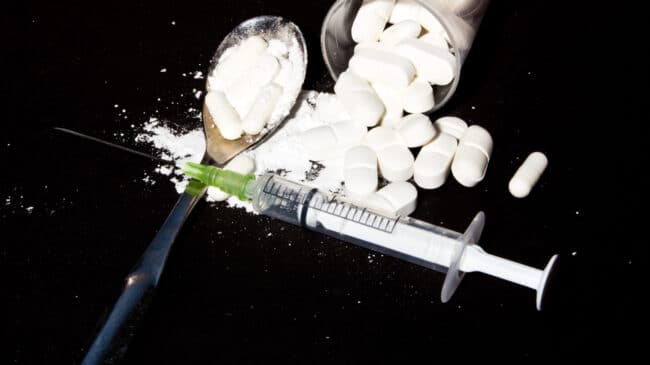New data from the National Center for Health Statistics (NCHS) confirm that over 100,000 people died from drug overdoses in 2021, the highest level in American history. Various researchers and reporters have cited a plethora of causes, including people having less access to addiction treatment, higher levels of addiction due to “financial difficulties, mass unemployment, isolation, the fear and anxiety and uncertainty of the pandemic,” and insufficient distribution of naloxone during the pandemic. While all of these descriptions play a role in some overdose deaths, none of them are the driving cause of record overdoses. And accepting a false narrative will likely prevent policymakers and the public from confronting the true underlying cause of the drug-overdose crisis.
Figure 1. Drug Overdose Deaths by Substance
Source: Years 1999 to 2020 from CDC WONDER; Year 2021 reports preliminary data from NCHS.
Addiction in the United States has been dropping for the last 20 years (Figure 2). Opioid addiction, in particular, has been dropping for approximately 10 years. In 2002, 9.4 percent of Americans were addicted to a drug, including 0.7 percent of Americans addicted to opioids. In 2019, the last year measured with a comparable standard (DSM-IV), 7.4 percent of Americans were addicted to substances with 0.6 percent of those being addicted to opioids. Additionally, record levels of naloxone and addiction treatment medications are being distributed, which means more people received addiction treatment in 2021 than any other year in American history.
Figure 2. Addiction Rate (%) in the U.S. by Substance Over Time
| 2002 | 2003 | 2004 | 2005 | 2006 | 2007 | 2008 | 2009 | 2010 | 2011 | 2012 | 2013 | 2014 | 2015 | 2016 | 2017 | 2018 | 2019 | |
| Opioids | 0.7 | 0.7 | 0.7 | 0.7 | 0.8 | 0.8 | 0.8 | 0.8 | 0.9 | 0.9 | 1.0 | 0.9 | 0.9 | 0.9 | 0.8 | 0.8 | 0.7 | 0.6 |
| All Drugs | 9.4 | 9.1 | 9.4 | 9.1 | 9.2 | 9 | 9 | 9 | 8.8 | 8 | 8.5 | 8.2 | 8.1 | 7.8 | 7.5 | 7.2 | 7.4 | 7.4 |
Sources: Key Substance Use and Mental Health Indicators in the United States: Results from the 2019 National Survey on Drug Use and Health, SAMHSA; Behavioral Health Trends in the United States: Results from the 2014 National Survey on Drug Use and Health, SAMHSA.
Fewer Americans are addicted to drugs and more of those who are addicted are receiving medication-assisted treatment for addiction, yet more people are dying from drug use. So, what is going on?
The reality is that drug addiction and drug-related deaths don’t have much of a relationship. Drug-related deaths are almost solely caused by the safety of the drug supply, which is made more dangerous by successful drug enforcement.
Public health interventions like prescription drug monitoring programs (PDMPs), which have been implemented in recent years to reduce opioid prescribing—and have successfully reduced the numbers of opioids prescribed by doctors since 2012—have motivated more drug users to resort to the black market for their fix. And when law enforcement becomes more successful at seizing illegal drugs, traffickers increase the potency of their narcotics to evade detection.
For example, as the Drug Enforcement Administration (DEA) successfully seized increasing amounts of heroin between 2010 and 2014, they soon started to seize fentanyl instead in the years following. During this shift, overdoses by fentanyl replaced those caused by heroin, but at a higher rate. And now those with substance use disorder are dying at such a high rate that overdoses are spiking despite a shrinking population of regular drug users. That means addiction is dropping in the U.S., but our drug-enforcement policies are killing more drug users by driving them to potent, unregulated products like fentanyl.
Some media outlets are starting to better connect these relationships. U.S. News & World Report, for example, recently reported “Teen Overdose Deaths Have Soared, Even Though Drug Use Hasn’t,” which could have been written about most age groups in the U.S. Reason has written about this false relationship for decades. But if we are to finally address drug-related deaths in this country, we will need this insight to become common knowledge amongst policymakers, public health officials, and the public-at-large.
Lawmakers intentionally reduced the rates of legal opioid prescribing by doctors, but drug-related deaths in the United States continue to climb to unprecedented heights every single year. If the U.S. continues its failed drug war approach, Americans should, sadly, expect even more overdose deaths in the years to come, as black market drug producers will continue to have incentives to create more potent products.
Americans can have fewer drug users or fewer drug overdoses, but it is unlikely to have both. Let’s hope that the country reconsiders its opioid policies and opts to be a humane society that leans towards more freedom and less death.

